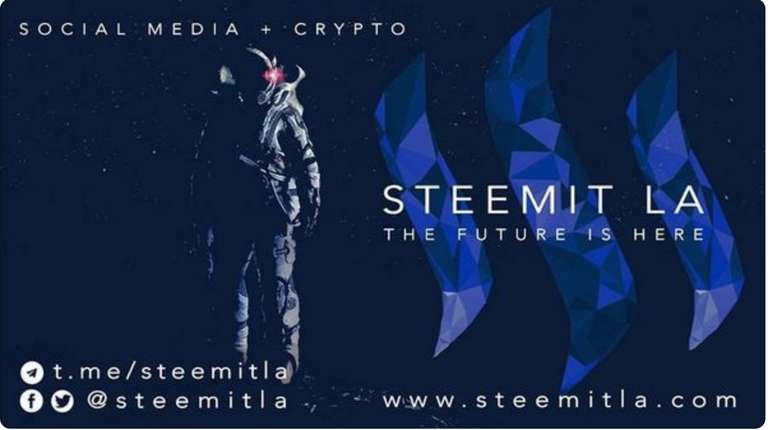
It’s been feeling pretty amazing as I promote SteemIt and how SteemIt technology is positively changing many Steemians' lives worldwide. Glad I’ve been able to record some of those conversations in which I’ll get to share with you all soon. I look forward to continuing to promote SteemIt even more, on a larger scale, in order to inspire and empower dreams and growth all over the world.
I’ve been anticipating @SteemItLA’s 2nd meetup for the last few weeks since I discovered the group right after the first meetup took place. It's an exciting opportunity to finally meet fellow Steemians in person! I must’ve been thinking about SteemIt and the @SteemitLA community so much that I had a dream about already being there last week.
I look forward to sharing more after the SteemitLA Meetup #2 today (2/26/18)!
 (https://steemit.com/steemit/@steemitla/meetup-steemitla)
(https://steemit.com/steemit/@steemitla/meetup-steemitla)
I wanted to share an educating video on blockchain technology from a work presentation on: What is blockchain, key concepts and terms, types, benefits, challenges, real world blockchain applications, and how blockchain effects in the digital advertising industry. I’ve included some information from the slides below.
Enjoy!
What is Blockchain
Blockchain is a ledger, or a database, that is stored in a distributed peer-to-peer network without any central point of control.
While special permissions are required to write entries to the blockchain, in most cases, the ledger itself is publicly visible.
Once an entry is made to the blockchain, it is pushed out to the network and is immutable, meaning that it can never be changed.
Blockchain is a generic term. Several blockchains exist such as Ethereum.
Plain English Definition
Blockchain provides a method for two parties to exchange value securely on a peer-to-peer network.
Blockchain creates a record of the transaction on the network that cannot be removed and are transparent to all parties.
What's truly unique about blockchain is that the transaction and the value exchange happen directly between the parties without intervention from any intermediaries such as a bank or credit card company.
Blockchain Applications
• Bitcoin
• Distributed Cloud Storage • Digital Identification
• Smart Contracts
• Digital Voting
Blockchain Key Concepts and Terms
• Decentralized – transactions are recorded in multiple locations instead of one location
• Immutable – cannot be changed
• Tokens or Coins – digital assets that can represent a value or a right
to participate in a network
• Smart Contract – a series of ‘if... then’ statements which make the contract self-governing and self-executing
• Cryptography – the technology and math used to hide secret messages – every entity in a blockchain must own a pair of cryptographic keys (one public and one private)
• Hashing – the process by which data is encrypted. Raw data is input, an operation is performed on the data and hashed data is output
Blockchain Types
• Private – owned and operated by a single entity, such as a bank
• Permission-Based – permission is required to read the information
on the blockchain – this limits the parties that can transact on it
• Public – anyone can participate without permission – anyone can send and read transactions
Blockchain Benefits
• Trust – a proven framework for creating trustworthy interactions
• Transparency – every transaction is visible to all parties in the chain • Decentralization – no central system, record or controlling party
• Safety and Security – no single point of failure
• Fraud Reduction – all parties are disclosed and verifiable
• Efficiency – no intermediaries required which results in cost reduction
Blockchain Challenges
• Terminology – will require a consistent and agreed upon nomenclature and taxonomy
• Speed – process of writing to a blockchain must become much quicker
• Cost – resources are required to become a peer on any blockchain, and there must be a real ROI to replace existing systems
• Identity Management – need a way to ensure a quality and trusted experience where consumers can manage their data
• Legal and Regulatory Issues – need some form of regulation and governance
Blockchain is a transparent ledger, or accounting system, that is decentralized, and because it is spread across a network of computers that verify the ledger, it is secure, transparent, and accurate.
The problem is that it takes a long time to update the blockchain across all of those computers, so you can only update the ledger at slow speeds, like 10 times a second or even slower.
Real World Blockchain Applications
Identify Verification
• Greater Confidence in Integrity and Accuracy of Customer Insights
• Better Customer Service
• Claiming Social Media Profiles
Loyalty Programs
• Verify Loyalty Member
• Combine Loyalty Programs across Silos
Track Provenance
• Verify if consumer goods are authentic
HR Based Solutions
• Background Checks
• Confirm an Applicants History (College, Work Experience, Etc)
Distributed Apps
• Easily move Photos from One App to Another
• Easily move Bitcoin Addresses from One Wallet to Another
▶️ DTube
▶️ IPFS
Peace, Abundance, and Liberty Network (PALnet) Discord Channel. It's a completely public and open space to all members of the Steemit community who voluntarily choose to be there.Congratulations! This post has been upvoted from the communal account, @minnowsupport, by ericphan from the Minnow Support Project. It's a witness project run by aggroed, ausbitbank, teamsteem, theprophet0, someguy123, neoxian, followbtcnews, and netuoso. The goal is to help Steemit grow by supporting Minnows. Please find us at the
If you would like to delegate to the Minnow Support Project you can do so by clicking on the following links: 50SP, 100SP, 250SP, 500SP, 1000SP, 5000SP.
Be sure to leave at least 50SP undelegated on your account.
Hi! I am a robot. I just upvoted you! I found similar content that readers might be interested in:
https://www.iab.com/wp-content/uploads/2018/02/Blockchain_for_Video_Advertising_Publisher-Buyer_Use_Cases_2018-02.pdf